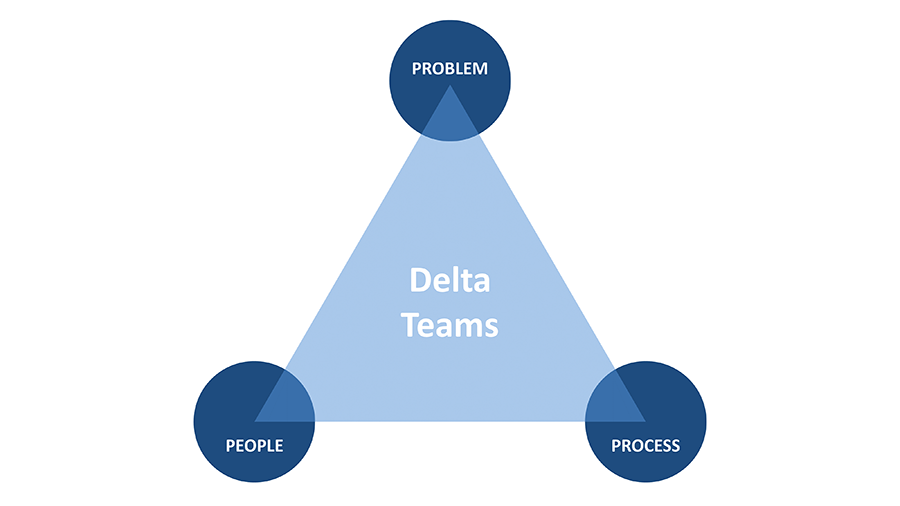Delta Team workshops are a novel approach to solving your most intractable strategic problems
A large, successful division within a large, successful materials company was at a crossroads. Significant increases in competition were eroding their market share. Their pipeline of new offerings had stalled out, and despite a deep bench of excellent technical minds, they struggled to find and capture opportunities. After ten years of relatively uncontested market leadership, they lacked the innovation mindset necessary to get unstuck.
Fearing the demise of a critical business, the head of research reached out for support. He knew that major changes were needed to defend against encroaching competition and reinvigorate the division’s pipeline, but he wasn’t sure where to start. Preliminary customer interviews indicated that there were opportunities to gain back share by resolving issues with existing products, so Newry set out to address that low-hanging fruit with one of the most consistently effective problem-solving techniques in our arsenal: the Delta Team.
THE DELTA TEAM APPROACH
Part skunkworks and part scrum, a Delta Team consists of a cross-functional group of creative thinkers drawn from within an organization. These participants meet on a regular basis to address a specific and highly critical problem that requires “out of the box” thinking to be resolved. This process can last anywhere from four months to over a year, but the lifespan of the Delta Team is finite by design, and the group disbands once their original objectives have been met.

Under the right conditions, Delta Teams are a highly effective way of creating meaningful change through the process of iterative experimentation, discovery, and refinement. The groups we’ve worked with have achieved cost savings on the order of hundreds of millions of dollars; process innovations that have led to breakthrough products; technology development initiatives that have born (profitable) fruit for years; and more. While the path to success isn’t always linear, and the solution rarely takes a form that anyone predicted, these teams ultimately accomplish incredibly positive results.
The secret to a successful Delta Team is threefold:

Delta Teams are reserved for big, urgent problems that have clear (ideally quantifiable) consequences if left unresolved. The members must be assembled from a range of different functional groups and should include the smartest, most creative, and most productive people in the organization. These individuals must dedicate part-time effort over many months, so this collaborative, iterative, and consistent process works best when it includes and is endorsed by top-level executives.
The Right Problem
Attack an “executive-level” challenge
Delta Teams work best to address problems that have a significant and quantifiable impact on sales and / or profitability of an organization. Most often, the obstacle in question is either a major manufacturing bottleneck or dysfunction within the product innovation process. Either way, it must be something that leadership is deeply invested in resolving – otherwise, the group will struggle to get traction.
This is partly a logistical issue: Delta Teams periodically interrupt day-to-day operations, so buy-in from the top is necessary to ensure access to resources. Executive visibility is also a motivational issue: your team members want to contribute, but they need to know that the effort is worth their time, and that their findings, intuition, and recommendations will be taken seriously. Knowing that the project has direct line of sight to senior leadership is an effective way to create extra energy. We have found that this distinction can inspire someone to take ownership and try something that they were initially hesitant about.

Invest in defining the problem well
Even once you’ve chosen what to focus on, you must define the specific parameters of the problem. Before even beginning to consider potential solutions, we spend a significant amount of time – often a full session or more – articulating our objective and criteria for success. There are three major components to our first-session process:
- Preparation: Newry works with the leader or sponsor of the effort to draft a problem statement ahead of the first meeting. That leader should come prepared to take a strong position on the objective to be achieved but must also be flexible enough to adjust their perspective based on the group’s input.
- Education: Before any in-person refinement of the problem statement begins, we spend a significant amount of time making sure every member of the Delta Team is brought up to speed on the nature of the problem and possible vectors for a solution. These presentations are led by the team members and functional experts themselves.
- Refinement: Finally, we facilitate a discussion around where the objective statement should be changed, taking the information presented by various team members into account. This step leads to a goal that is always more clearly stated, more accurate, and has the group’s buy-in.
As a rule, the original objective (as drafted by the sponsor) almost never remains intact by the end of the first meeting. In one engagement, the team realized that the leader’s draft problem statement was loaded with a major assumption about the nature of the likely solution. They agreed that the objective as stated could bias their problem-solving process and made some subtle but important changes to refine the scope of inquiry while also sharpening their target outcomes with specific metrics. A good leader should embrace these revisions, as the process of discussion and critique helps gain buy-in and focus the group’s efforts.
Set SMART(R) objectives
Your objective should have clear parameters that are not completely unrealistic but will stretch the team’s capabilities. Many innovation and business leaders are familiar with the acronym SMART (Simple/Specific, Measurable, Actionable, Relevant, Time-bound), which is used to test or improve the quality of a problem statement. SMART is an excellent pneumonic for clarifying your goals in a wide range of problem-solving situations, and Delta Teams are no exception.
However, we’ve found that Delta Team participants tend to be conservative at the outset – perhaps due to the visibility and high-stakes nature of the problems they have been charged with solving – and sometimes need to be pushed out of their comfort zone. The harder the objective is to achieve, the more wide-ranging the proposed solutions are likely to be – and the better the final outcome. Hence the extra “R” – for “Reach” – which we use to remind ourselves and the team to push the thinking even further.

One team we worked with spent a lot of time debating the ideal timeline and monetary impact of their effort. Many participants were reluctant to agree to targets they felt were too ambitious, fearful of falling short, but the group leader ultimately convinced the whole team to aim high. The effect of setting such aggressive goals was immediately noticeable: the whole group came alive, generating hundreds of ideas within the first session, fiercely debating which ones should be grouped together and prioritized, and sharpening the top concepts to be tested. Ultimately, the combined projected impact of the best ideas that fell out of this process exceeded the team’s financial objective by more than 2X.
The Right People

Recruit all-stars from across the organization
A successful Delta Team unites an organization’s best “thinkers” and “doers” who are focused on learning about the nature of a problem, its components, and then attacking it from multiple vantage points. Participants can vary as the team’s focus shifts, but at their best, these innovation teams involve people who may not normally cross paths and have the capability to follow up and experiment with potential solutions/strategies that result from the “organized serendipity” of new team-based interactions.
This is where having an executive-level sponsor comes in handy. Under normal circumstances, securing time, energy, and focus from the organization’s best minds – across disciplines and over a time period of several months, no less – is challenging, if not impossible. When leadership is brought in and committed to finding a solution, however, scheduling and commitment challenges are lessened significantly.
Ensure diverse, expert perspectives
The interdisciplinary nature of the Delta Team is critical in avoiding blind spots that so often plague more siloed groups. It does no one any good to have a bunch of business strategists or human factors designers in the room without someone who knows whether potential solutions are even physically possible. Bringing in participants from multiple departments is an important step in making sure you’ve got your bases covered, but it isn’t always enough to close all the gaps. If you don’t have the right capabilities, it may be worth including outsiders who can either act (e.g., address complex or specialized technical hurdles from a novel point of view), influence (e.g., provide credible, objective guidance based on their previous experience), or both, and don’t take a long time coming up the learning curve.
Incorporating a diverse group of people into the team can also reveal unforeseen elements of the problem, and/or unexpected solutions. In one Delta Team, we focused the bulk of our effort on engineering-led solutions for a technical problem. As we’d hoped, the team made significant progress on new innovation paths over the following months and increased the efficiency of their process. However, toward the end of the project, it became clear that the biggest positive impact of the Delta Team was not related to these manufacturing improvements; rather, it was in the improved information sharing practices between the sales team and the engineering organization.

The conversations that took place both during and outside of the Delta Team meetings revealed that the root cause of the problem was a simple yet fundamental recurring misunderstanding about customer expectations and internal timelines. What was originally thought of as a problem with a technology solution turned out to be as much (or more) a communication issue – one that the Delta process successfully resolved.
Pick a team leader with high EQ
The best type of team leader is often not the “singular visionary genius” type, especially on a Delta Team. Instead of taking center stage, the leader needs to help set the vision and get buy-in from the rest of the group. This person should act as a guide and connector, as opposed to a general barking orders. It is also often helpful to have someone else – either a trusted internal deputy or an external facilitator – help the leader manage the team to make sure people are connecting, working together, and making progress outside of the meetings. Since follow-up takes time, this other person can devote energy towards planning meetings and pushing things forward internally.
One particular leader stands out in the way he focused his time during the Delta Team process. He was under pressure to create meaningful change for R&D, engineering, and the business unit, and his team faced myriad challenges, from faster competitors, to lack of software development capability, to questionable support for a potential technical solution. However, rather than trying to personally lead the charge to find the answer, he spent most of his time thinking through the “people” side of things: the make-up of the team, the meeting agendas, the atmosphere of the sessions, etc. His attention to detail ensured that everything from the set-up of the meeting room, to the time allocations of the team members, to the budgets for experimentation were arranged so that team members could be as productive as possible.
The Right Process
Maintain a disciplined and consistent cadence of meetings
In many challenging situations, in business and in life, it’s enough to have the right people pointed toward the right problem. The bulk of our clients’ success is built on the ability of their exceptionally talented R&D folks to achieve major breakthroughs on a consistent basis. However, for the types of problems that Delta Teams are designed to solve – those stubborn, persistent challenges that even the most well-oiled innovation machines can’t seem to crack – it’s just as important to have the right process.

Many of our clients elect to engage in a 2-day kickoff, with a focus on education and team building. The second day is usually filled with brainstorming potential solutions. These are likely lacking in detail, perhaps only a few words or a sentence, but capturing them is the first step. A separate meeting with a smaller group of 4 or 5 leaders is conducted to help facilitate and organize the process, allowing them to speak in more detail and refine the list. This revision of the list may include removing duplicates or ideas that aren’t clear, grouping the ideas into categories, or perhaps even reassessing the composition of the team and rotating members off or on to better target the problem.
A regular cadence of meetings is important, ideally with in-person sessions taking place every 3-4 weeks during the initial phase to update each other on progress and explore whether efforts are working. As the group coalesces around several high-potential solutions and is actively experimenting and testing solutions, the cadence of meetings may slow. However, it is important to maintain consistent agendas at the meetings that include a clear focus on the objective, reporting out of learnings, opportunity for discussion and vigorous debate, and articulation and prioritization of next steps.
Encourage constructive disagreement
Debate is integral to the Delta Team process. In 2014, Harvard Professor Linda Hill gave a brilliant TED Talk presenting her research on innovation leadership in what she has dubbed “collective genius.” The talk and subsequent book make a compelling case for meaningfulness of three critical capabilities, which, if properly managed, will enable company leaders to successfully manage their organizations. According to Professor Hill, incorporating Creative Abrasion, Creative Agility, and Creative Resolution will help create the culture and environment “where people are both willing and able to do the hard work that innovative problem solving requires.”
We shouldn’t expect “the answer” to fall out, already fully formed, from a single brainstorm (too often I suspect this is our hope, but clearly it is unrealistic). To get traction and keep progress moving requires consistent cadence of findings, delivery, and accountability. As Professor Hill experienced: “Don’t confuse creative abrasion with brainstorming. Both seek to develop as many ideas as possible. The difference is that creative abrasion, as its name implies, includes the ongoing discussion, evaluation, and critical comparisons of ideas, while brainstorming forbids critical comments in favor of generating as many ideas as possible, no matter how farfetched.”
In a recent Delta meeting, a vigorous discussion arose when one team member questioned the merits of another’s approach. The conversation became heated as the first individual challenged his peer’s findings, but never crossed the line of respectfulness or civility. It was clear that the intensity of the debate arose not out of animosity, but rather from a deep mutual desire to solve the problem. Ultimately, the first team member was able to leverage his passion and curiosity to help tailor a set of experiments to arrive at a new level of understanding for everyone. The Delta Team setting allowed for this debate where some level of frustration was shown, but ultimately got the two parties to combine their efforts and expertise in a new trial.
Use social mechanisms to drive accountability
The best Delta Teams don’t just look different from the typical project team – they feel different. There’s a sense of trust, of camaraderie, of being in the trenches together. Everyone is bought in to doing whatever it takes to find a solution. Eventually, people are spending their weekends perfecting a demo to show the group in the next meeting simply because they’re excited to move the problem forward and because they’re motivated to show up for their teammates.
Of course, this environment doesn’t spontaneously generate itself. Getting to this point often takes a fair amount of social engineering. In one of the first Delta Teams we conducted, we made time for group lunches and dinners in addition to the rigorous schedule of regular meetings. We all went on manufacturing site visits together, treating them as “field trips” that would give the group an opportunity to bond. Over time, the whole team – which was composed of people who previously had not spent much time collaborating (and had not bothered to get to know each other) – really evolved their style of interacting with each other, creating a culture shift that lasted well beyond the formal engagement.
THE DELTA TEAM IMPACT
Let’s return to the first client we talked about – the large division that was facing increasing competition and share loss after a decade of market leadership. At the behest of the head of research, Newry assembled and launched a Delta Team with some of the group’s best technical and commercial minds. Our goal was to address the shortcomings of one of their main product offerings, and hopefully initiate additional technical development efforts to drive future sales.
In the months that followed, the Delta Team developed a solution that massively decreased the cost of installation for their products, giving them a significant leg up over their competitors. They also explored technical paths that ultimately resulted in their next killer offering. This focused problem-solving effort rekindled a spirit of invention and collaboration within the division. Altogether, the long-term impact of this engagement has been on the order of hundreds of millions of dollars.

What makes the Delta Team process so powerful? It’s not rocket science. Anyone can gather up a bunch of smart people, stick them in the same room, and tell them to figure out a solution to a problem. And yet, that sort of thing doesn’t happen very often – and when it does, it tends to be a haphazard one-off that doesn’t really go anywhere. By contrast, the Delta Team approach is a thoughtful, intentional, and sustained method of problem definition and solution development, with specific parameters and best practices that have been honed over two decades. This carefully designed combination of problem, people, and process almost always yields something larger than the sum of its parts. In the hands of an experienced facilitator, a conscientious team leader, and an enthusiastic internal champion, Delta really does make a difference.
Find out how Newry can help your organization move smarter to move faster. Get traction in your market.
